This story was originally published by Megan Eckstein, USNI News on September 1, 2020.
The airborne command and control planes have been in operation in the carrier air wing since 2015 but have, until now, not been able to refuel in the air. When the planes get low on fuel, regardless of what targets they’re tracking or what communications they’re helping relay, they need to circle back to the aircraft carrier, land and refuel on the flight deck.
The “Seahawks” of Airborne Command & Control Squadron (VAW) 126 accepted their first aircraft modified to conduct air refuelings on July 27. Two pilots in the squadron qualified for aerial refueling on Aug. 14, making them the first pilots in an operational squadron to do so. Since then, the rest of the unit’s pilots have continued to conduct the necessary day and night evolutions to become certified as well, with at least 10 pilots now qualified.

Lt. Nicholas Dewispelaere, a pilot and line division officer with VAW-126 who was one of the first in the squadron to qualify for aerial refuelings, told USNI News in an interview that the Navy had created a great training syllabus that involved first conducting the maneuver in a simulator and then getting up in the air with Air Force KC-707 and KC-10 tankers. He said VAW-126 qualifying its pilots is the culmination of thee years of work, with the VAW-120 training squadron doing the heavy lifting to work out what the evolution looked like and how to train pilots to safely conduct the maneuver for the first time.
“As a pilot, it’s awesome. … It’s very fun flying, it’s precision flying, and as a naval aviator we always pride ourselves in precision flying. Case and point, being able to put the aircraft in a very specific spot. Approaching the KC-707 was a lot of fun, forming up on them, going through the drills. Having the instructor pilot next to you kind of coaching you through was great for making you feel comfortable. Like I said, the [simulators] also got you to a level of proficiency where you definitely felt comfortable getting behind. And then once you get behind the basket you get about 10 feet to go nice and stable, then you just add a little power to make contact, and it’s a lot of fun.”
Lt. Nicholas Dewispelaere, pilot and line division officer with VAW-126
Dewispelaere, who himself has conducted about 30 day and night refuelings this summer, said VAW-126 got back from a deployment with the Harry S. Truman Carrier Strike Group in June and then began tackling the aerial refueling capability.

“Before being air refueling (AR) capable, we would just get our gas normally: we’d walk into a plane already fueled up, and then we would be able to do hot-pumps in which we’d be able to land, keep one of the engines running, fuel up and then get the other engine that we turned off started up again and launch for a quick turnaround, he said.
“Those were always good evolutions – not very difficult for the aircrew itself, the maintainers always do a good job getting us gas and getting us back airborne quickly. But that does take time: it requires us to land, it requires us to make an approach, it requires some of the maintainers to meet us up on the flight deck. So being AR capable, we’re able to skip past, bypass that whole evolution, which will increase our time on station. And with being able to get gas airborne, we’re just able to stay on station and provide that command and control longer” without leaving any gaps in coverage.
The next step for these pilots will be learning to do an aerial refueling with the F-18F Super Hornet, which the Navy uses within its carrier air wing to conduct “buddy-to-buddy” refuelings with aircraft organic to the air wing, without relying on outside help from a land-based tanker.
Prior to this milestone, the best an E-2D squadron could do to achieve continuous coverage was to launch a second E-2D from the carrier before the first was low on fuel, allowing the first plane to pass the mission off to a second plane without leaving any gaps. Still, adding aerial refueling will add more flexibility: that second aircraft could be in the air simultaneously monitoring tracks in a different part of the air and sea space around the carrier. An E-2D could take on mission farther from the carrier without worrying about fuel limiting its range. The carrier strike group could be certain it could have continuous coverage, even if the VAW squadron had down aircraft that maintainers were trying to fix.
“The idea behind it is just so we can keep the very capable sensors and radar that we have on the E-2D Advanced Hawkeye airborne longer, so that we can always provide for the defense and situational awareness of the carrier strike group,” Dewispelaere said. “I think it provides flexibility for the carrier strike group and increases the lethality of the carrier strike group in general, being able to stay airborne and not having to return back and get gas, especially if there’s a serious mission that we are required to stay airborne for.”
It’s still too early to say exactly how tactics, techniques and procedures for the E-2D will change based on being able to refuel in air and stay on station longer. VAW-126 Commanding Officer Cmdr. Marc Foreman told USNI News that those changes would happen at a higher echelon but that VAW-126, as the first squadron with this capability, would play a direct role in helping inform those decisions and test out new tactics.

“It does create a lot of flexibility. We’re going to break ground on this and see where it goes, what that looks like,” he said. “Right now our focus is just on safety and safely executing this properly, and seeing where we go from here and what game-changing things it brings to us.”
In December 2016, Northrop Grumman completed the first flight of a modified E-2D equipped with the aerial refueling modifications. In July 2017 the aircraft conducted its first aerial refueling mission, with several “dry plugs” and two actual “wet plugs” that passed more than 1,700 pounds of fuel from a U.S. Navy KC-130 Hercules to the E-2D. VAW-120 has since been working to refine the processes and the syllabus to teach it to the operational fleet, and in September 2019 the squadron took control of its first AR-capable plane, according to Naval News.
A Navy news release says it took “a significant airframe modification” to allow the E-2Ds to take on fuel from a tanker. “The Seahawks are currently qualifying all of their pilots in day and night Aerial Refueling on the Omega 707 and KC-10 platforms. The Seahawks will work to expand their pilot’s AR experience to other tanker platforms, including the F/A-18 Super Hornet and KC-135 Stratotanker, at the same time developing the techniques and procedures for training and employment of this new capability.”
According to a Naval Air Systems Command web page, by the end of this fiscal year “the E-2D will achieve initial operational capability (IOC) with aerial refueling (AR) capability. With AR, the all-weather, carrier-based tactical battle management airborne early warning and command and control aircraft will be able to remain airborne to the limits of the aircrew and airframe endurance. Aerial refueling-equipped aircraft will also feature new endurance seats, fuel system enhancements, and new exterior lighting. Aerial refueling increases the range and persistence of the E-2D AHE. The ‘eyes of the fleet’ will see further and wider, equipping the warfighter for ever-evolving threats.”
A version of this post originally appeared on USNI News. It’s been republished here with permission.





